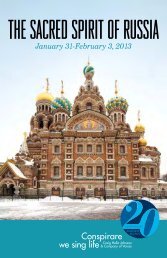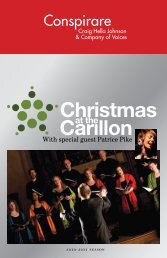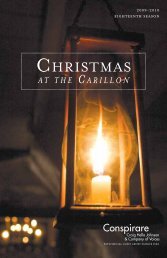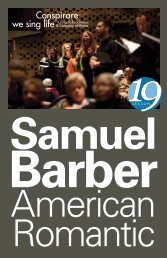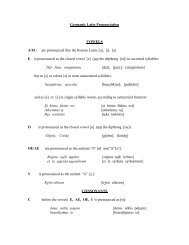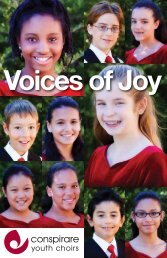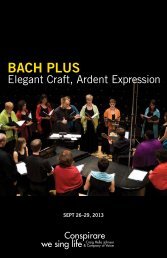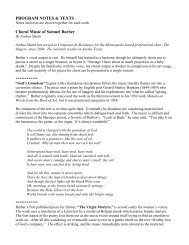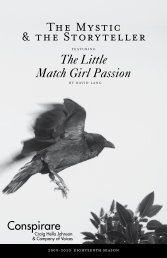Roberto Sierra's Missa Latina - Conspirare
Roberto Sierra's Missa Latina - Conspirare
Roberto Sierra's Missa Latina - Conspirare
- No tags were found...
Create successful ePaper yourself
Turn your PDF publications into a flip-book with our unique Google optimized e-Paper software.
PROGRAM<strong>Roberto</strong> Sierra’s<strong>Missa</strong> <strong>Latina</strong><strong>Missa</strong> <strong>Latina</strong> ‘Pro Pace’ <strong>Roberto</strong> Sierra (b. 1953)Introit: Da pacem, DomineKyrieGloriaCredoOffertory: Rogate quae ad pacemSanctusAgnus DeiHeidi Grant Murphy,* sopranoDaniel Teadt, baritone<strong>Conspirare</strong> Symphonic Choir<strong>Conspirare</strong> Company of VoicesTexas State ChoraleVictoria Bach Festival Orchestra and ChorusCraig Hella Johnson, conductorProgram NotesThere is a tradition, centuries long, that musical settings of the Mass treatthe five sections of the Mass whose text never changes, known collectively asthe Mass Ordinary. The reason for this is that such a setting could be used(theoretically) any time the Mass was celebrated. A composer could certainlyinclude additional portions of the Mass, but any such portions would be fromthe Mass Proper which changes according to the season of the church calendarand the particular Sunday.This setting opens, then, with the Introit assigned in the Liber Usualis for the18th Sunday after Pentecost (p. 1056). Sierra’s Offertory combines a Gradualand Alleluia from a Mass to Beg for Peace (p. 1285) with an Offertory fromthe Mass for the Fourth Sunday of Lent (p. 562). The composer also adds tothe Agnus Dei the Communion from the Mass to Beg for Peace (p. 1287).Sierra writes, “The concept of my <strong>Missa</strong> <strong>Latina</strong> ‘Pro Pace’ came directly out ofmy experience growing up as a Catholic in Puerto Rico. I still recall vividlyhearing the Mass in Latin in my hometown when I was a child. Thesememories created a strong impression—one that has only deepened throughthe years: a sense of mystery combined with power and compassion in hearingGregorian chant intoned by the priest in a ritual involving this ‘dead’ language.“The title I chose—<strong>Missa</strong> <strong>Latina</strong>—has dual meaning. On the one hand itrefers to the traditional Latin text, while on the other hand the work is infusedwith a ‘Latino’ character: full of Caribbean gestures that allude to my ownHispanic heritage, and which are present in so many of my works. Thesesounds can be heard particularly in the ‘Laudamus te’ of the Gloria and the‘Pleni sunt caeli’ of the Sanctus.”*Heidi Grant Murphy is exclusively represented by Kirshbaum Demler & Associates, Inc.,711 West End Avenue, Suite 5KN, New York, NY 10025, www.kirshdem.com. Ms. Murphy hasrecorded for Koch International, Deutsche Grammophon, Telarc, and Arabesque Recordings.<strong>Missa</strong> <strong>Latina</strong> was co-commissioned by the National Symphony Orchestra ofWashington, D.C., Leonard Slatkin, music director, through a generous giftfrom the John and June Hechinger Commissioning Fund for New OrchestralWorks, and the Choral Arts Society of Washington, Norman Scribner, artisticdirector, through a generous gift from Anne B. Keiser and Charles Cerf.* * *4 5




